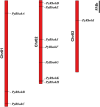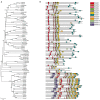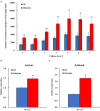Identification of Respiratory Burst Oxidase Homolog (Rboh) Family Genes From Pyropia yezoensis and Their Correlation With Archeospore Release
- PMID: 35903222
- PMCID: PMC9322803
- DOI: 10.3389/fpls.2022.929299
Identification of Respiratory Burst Oxidase Homolog (Rboh) Family Genes From Pyropia yezoensis and Their Correlation With Archeospore Release
Abstract
Reactive oxygen species (ROS) play important regulatory roles in plant growth and development, as well as in cell differentiation and stress responses. Respiratory burst oxidase homolog (RBOH) is the key enzyme in ROS production. So far, the Rboh family genes in Pyropia yezoensis have not been comprehensively characterized, and whether their function was involved in the formation of archeospores is still unknown. In this study, a total of 11 PyRboh genes were identified from the P. yezoensis genome by homology mining. Through phylogenetic analysis, it is suggested that the PyRboh genes were evolutionarily conserved among the lineages of red algae, but a few genes exhibited a species-specific manner. The treatment of P. yezoensis blades with NADPH oxidase inhibitor diphenylene iodonium (DPI) could significantly inhibit the formation of archeospores, suggesting that RBOH may be involved in the formation of archeospores. According to PyRboh gene expression analysis using the P. yezoensis strains with obvious differences in releasing archeospores, it is showed that the expression trends of most genes were consistent, with no significant difference between strains, whereas the expression pattern of the two P. yezoensis-specific genes (PyRbohJ and PyRbohK) was positively correlated with the amount of archeospores. Furthermore, as treatment of blades with allantoin resulted in a significant increase in the release of archeospores, the expression levels of PyRbohJ and PyRbohK were also consistently upregulated, further confirming the relationship between the two genes and archeospore formation. These findings provide insights into the molecular mechanism of P. yezoensis archeospore formation.
Keywords: DPI treatment; Pyropia yezoensis; RBOH gene; archeospore; evolutionary analysis.
Copyright © 2022 Gui, Gao, Ding and Yan.
Conflict of interest statement
The authors declare that the research was conducted in the absence of any commercial or financial relationships that could be construed as a potential conflict of interest.
Figures







Similar articles
-
VARIATIONS IN THE CELL WALLS AND PHOTOSYNTHETIC PROPERTIES OF PORPHYRA YEZOENSIS (BANGIALES, RHODOPHYTA) DURING ARCHEOSPORE FORMATION(1).J Phycol. 2011 Aug;47(4):839-45. doi: 10.1111/j.1529-8817.2011.01003.x. Epub 2011 Jun 15. J Phycol. 2011. PMID: 27020020
-
Genetic similarity analysis within Pyropia yezoensis blades developed from both conchospores and blade archeospores using AFLP(1).J Phycol. 2013 Jun;49(3):517-22. doi: 10.1111/jpy.12058. Epub 2013 Mar 21. J Phycol. 2013. PMID: 27007040
-
CHIMERAS WITH MOSAIC PATTERN IN ARCHEOSPORE GERMLINGS OF PYROPIA YEZOENSIS UEDA (BANGIALES, RHODOPHYTA)(1).J Phycol. 2012 Jun;48(3):706-9. doi: 10.1111/j.1529-8817.2012.01143.x. Epub 2012 May 3. J Phycol. 2012. PMID: 27011087
-
NADPH oxidases and the evolution of plant salinity tolerance.Plant Cell Environ. 2020 Dec;43(12):2957-2968. doi: 10.1111/pce.13907. Epub 2020 Oct 26. Plant Cell Environ. 2020. PMID: 33043459 Review.
-
Plant signaling networks involving Ca(2+) and Rboh/Nox-mediated ROS production under salinity stress.Front Plant Sci. 2015 Jun 10;6:427. doi: 10.3389/fpls.2015.00427. eCollection 2015. Front Plant Sci. 2015. PMID: 26113854 Free PMC article. Review.
Cited by
-
The chimeric gene orf610a reduces cotton pollen fertility by impairing the assembly of ATP synthase.Plant Biotechnol J. 2025 Jul;23(7):2949-2962. doi: 10.1111/pbi.70105. Epub 2025 May 7. Plant Biotechnol J. 2025. PMID: 40333481 Free PMC article.
-
Histone acetylation functions in the wound-induced spore formation in nori.Front Plant Sci. 2022 Dec 8;13:1064300. doi: 10.3389/fpls.2022.1064300. eCollection 2022. Front Plant Sci. 2022. PMID: 36570923 Free PMC article.
-
Cell Mutagenic Autopolyploidy Enhances Salinity Stress Tolerance in Leguminous Crops.Cells. 2023 Aug 17;12(16):2082. doi: 10.3390/cells12162082. Cells. 2023. PMID: 37626892 Free PMC article. Review.
-
Genome-wide analysis of respiratory burst oxidase homolog gene family in pea (Pisum sativum L.).Front Plant Sci. 2023 Dec 12;14:1321952. doi: 10.3389/fpls.2023.1321952. eCollection 2023. Front Plant Sci. 2023. PMID: 38155848 Free PMC article.
-
Identification and expression analysis of the RBOH gene family of Isatis indigotica Fort. and the potential regulation mechanism of RBOH gene on H2O2 under salt stress.Plant Cell Rep. 2025 Feb 12;44(3):52. doi: 10.1007/s00299-025-03442-9. Plant Cell Rep. 2025. PMID: 39934507
References
-
- Chang Y., Li B., Shi Q., Geng R., Geng S. P., Liu J. L., et al. . (2020). Comprehensive analysis of respiratory burst oxidase homologs (Rboh) gene family and function of GbRboh5/18 on verticillium wilt resistance in Gossypium barbadense. Front. Genet. 11, 788. 10.3389/fgene.2020.00788 - DOI - PMC - PubMed
-
- Chen S. S., Ding H. C., Yan X. H. (2016). Selection and characterization of an improved strain of Pyropia chauhanii (Bangiales, Rhodophyta). J. Fish China 40, 933–945. 10.11964/jfc.20151210201 - DOI
LinkOut - more resources
Full Text Sources

